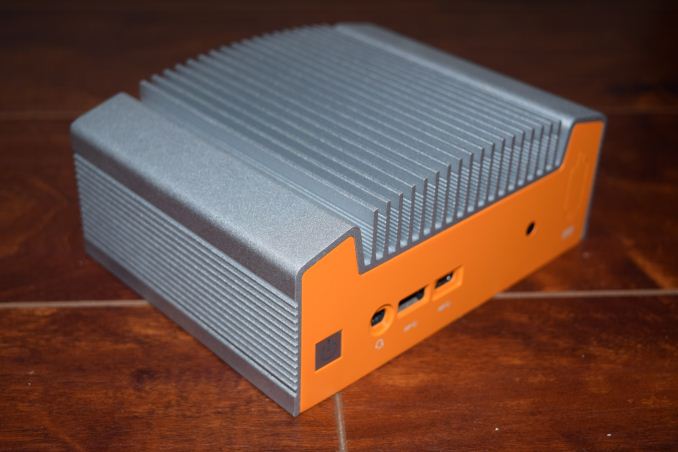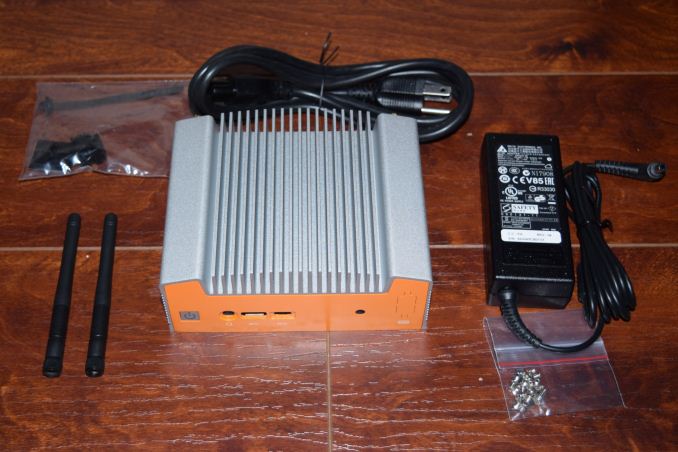Logic Supply ML100G-50 Fanless Skylake vPro Industrial NUC Review
by Ganesh T S on February 27, 2017 8:00 AM EST
The ML100 series of passively cooled PCs from Logic Supply utilize the NUC / UCFF (ultra-compact form factor) motherboards. Currently, that lineup includes Bay Trail, Broadwell, and Skylake-based units. The ML100G-50 that we are looking at today is the Skylake vPro version.
Introduction and Product Impressions
The ML100G-30 released in early 2015 came with a Broadwell vPro processor and used one of the Intel Broadwell NUC motherboards (NUC5i5MYBE). Logic Supply's expertise in passively cooled systems enabled the replacement of the fan in the kit with an effective fanless thermal solution. The ML100G-50, however, is equipped with an ASRock board that is similar in many ways to the one found in the ASRock Beebox-S 6200U. The main differences between the internals of the ML100G-50 and the Beebox-S 6200U are the processor (vPro-capable Core i5-6300U vs. non-vPro Core i5-6200U), the Wi-Fi card (Intel AC7260 in our review sample vs. Intel AC3160), and the Ethernet controller (I219-LM vs. I219-V, the former being necessary for vPro features). The internal layout (not the motherboard itself) is also slightly different, with the full-metal solution of the ML100G-50 making it necessary to have a couple of RP-SMA connectors in the rear panel. In terms of physical dimensions, the ML100G-50 is the same as the ML100G-30. Due to the thermal solution and the need for RP-SMA Wi-Fi antenna connectors, the dimensions are slightly larger than the ASRock Beebox-S 6200U (142mm x 107mm x 62mm vs. 119mm x 110mm x 46mm)
The full specifications of our Logic Supply ML100G-50 review configuration are summarized in the table below.
| Logic Supply ML100G-50 Specifications | |
| Processor | Intel Core i5-6300U (2C/4T @ 2.4GHz (Turbo 3.0 GHz), 14nm, 3 MB L2, 15W) |
| Memory | Transcend TS1GSH64V1H DDR4 15-15-15-36 @ 2133 MHz 2x8 GB |
| Graphics | Intel HD Graphics 520 |
| Disk Drive(s) | Transcend MTS600 TS128GMTS600 (128 GB; M.2 Type 2260 SATA III; Micron 20nm; MLC) |
| Networking | Intel Dual Band Wireless-AC 7260 (2x2 802.11ac - 867 Mbps) Intel Gigabit Ethernet Connection I219-LM |
| Audio | 3.5mm Headphone Jack Capable of 5.1/7.1 digital output with HD audio bitstreaming (HDMI) |
| Display | 2x HDMI (1x 2.0a, 1x 1.4b) 1x Display Port 1.2 |
| Miscellaneous I/O Ports | 1x USB 3.1 Gen 2 Type-C 3x USB 3.0 |
| Operating System | Retail unit is barebones, but we installed Windows 10 Pro x64 |
| Pricing | $871 (barebones) / $926 (default configuration) $1141 (as configured) |
| Full Specifications | Logic Supply ML100G-50 Specifications |
Logic Supply allows the ML100G-50 to be customized prior to shipping. By default, the unit comes with 4GB of DDR4-2133 RAM and a 32GB M.2 2260 SATA SSD. There is no WLAN support in the default configuration. Based on the purchase options, Logic Supply can pre-install up to two SO-DIMMs of 8GB each and a Transcend M.2 2260 SSD up to 512GB in capacity. Customers can opt to install their own SO-DIMMs (in which case, they can go up to 32GB of RAM) and/or M.2 2260 SSDs (Note that only M.2 2260 SSDs are officially supported - unlike the Beebox-S which allows M.2 2280 SSDs using an add-on plastic riser tab). Both SATA and PCIe drives are supported, though M.2 2260 PCIe SSDs are relatively rare in the market.
Other customization options include the WLAN card (the Intel AC8260 is available on the Logic Supply purchase page, though our review unit came with the AC7260). wall / VESA and DIN rail mounting kits, port and dust blocking kits, and choice of OS (Ubuntu 14.04 LTS, Windows 8.1 Embedded, Windows 10 Home / Pro / IoT Enterprise LTSB). While the standard warranty is 2 years, $99 extends that to 3.
We installed Windows 10 Pro x64 for the review process, and almost all drivers were available via the regular Windows Update process. The CIR driver (for the IR receiver) and the thermal framework drivers (Intel DPTF) had to be downloaded from ASRock's website for the Beebox-S 6200U
In addition to the main unit, the other components of the package include a 65 W (19V @ 3.42A) adapter, a US power cord, two 2.4 GHz / 5 GHz antennae for the Wi-Fi feature, adhesive rubber feet for the unit's base and a cable management tie along with some screws (probably for the wall mount / VESA mount - which is supported, but not included in our review package). The gallery below takes us around the chassis and also a view of the customer-accessible portion of the internals that allows the DRAM and SSD to be changed.
Note that there is a thick thermal pad right above the M.2 SSD. This should definitely help the drive keep its cool when subject to disk-intensive workloads. The all-metal construction and the finned structure of the chassis sides and top also help in drawing the heat away from the internal components. As usual, we will quantitatively evaluate the effectiveness of the thermal solution in a later section.
In the table below, we have an overview of the various systems that we are comparing the Logic Supply ML100G-50 against. Note that they may not belong to the same market segment. Of particular interest are the Logic Supply ML100G-30, the Logic Supply Core ML320, the Zotac ZBOX CI523 nano and the Zotac ZBOX CI540 nano - all of which are passively cooled U-series UCFF PCs. The relevant configuration details of the machines are provided so that readers have an understanding of why some benchmark numbers are skewed for or against the Logic Supply ML100G-50 when we come to those sections.
| Comparative PC Configurations | ||
| Aspect | Logic Supply ML100G-50 | |
| CPU | Intel Core i5-6300U | Intel Core i5-6300U |
| GPU | Intel HD Graphics 520 | Intel HD Graphics 520 |
| RAM | Transcend TS1GSH64V1H DDR4 15-15-15-36 @ 2133 MHz 2x8 GB |
Transcend TS1GSH64V1H DDR4 15-15-15-36 @ 2133 MHz 2x8 GB |
| Storage | Transcend MTS600 TS128GMTS600 (128 GB; M.2 Type 2260 SATA III; Micron 20nm; MLC) |
Transcend MTS600 TS128GMTS600 (128 GB; M.2 Type 2260 SATA III; Micron 20nm; MLC) |
| Wi-Fi | Intel Dual Band Wireless-AC 7260 (2x2 802.11ac - 867 Mbps) |
Intel Dual Band Wireless-AC 7260 (2x2 802.11ac - 867 Mbps) |
| Price (in USD, when built) | $871 (barebones) $1141 (as configured) |
$871 (barebones) $1141 (as configured) |

















37 Comments
View All Comments
zepi - Monday, February 27, 2017 - link
Out of curiosity, what kind of ambient temperatures do you have in your test-bench?There is quite a difference between 18C and 28C room temperature in this kind of test.
bill.rookard - Monday, February 27, 2017 - link
Ideally you would think they would set ambient temp (via heat or a/c as needed) to a flat 21C/70F or so which is what most people would have as an average 'comfortable' temp. 28C might be a bit high (82F) while the 18C (64F) is a bit chilly.Although, considering these are 'industrial' type systems, you might actually subject them to a much wider dual temp test (15C/60F and 32C/90F) which you might find in a warehouse or factory floor.
zepi - Monday, February 27, 2017 - link
This is what I'm referring to. If someone deploys this at factory floor, temperature variations might be completely out of your standard AC'ed office block.Knowing ambiet temp would definitely help people estimating the dT figures that it can handle.
ganeshts - Monday, February 27, 2017 - link
The ambient temperature for all our thermal testing is between 70 and 74F.For one of our previous industrial PC reviews, I did the stress testing at multiple temperature points - http://www.anandtech.com/show/6494/aleutia-relia-i... , but the overall feedback in terms of balance between time spent on a review and actionable results was that room temperature testing is more than enough.
If the customer is ordering, say, 20K or 30K worth of these PCs, I am sure Logic Supply would be more than happy to deliver those graphs for the particular workloads to be used at different temperature points [ just my opinion :) ]
Samus - Tuesday, February 28, 2017 - link
The issue I think he is raising is the typical ambient temperature of a ventilated kiosk or summertime warehouse is probably 90F. Who knows how high it is when not ventilated. For a review of an industrial PC, it would probably be appropriate to increase your ambient temp to real-world scenarios.SkipPerk - Wednesday, April 19, 2017 - link
Our facilities routinely top 105 in August. I had to use a laptop cooler to keep my Asus ultrabook from slowing down excessively. I updated both required PC's to large CPU coolers (Noctua NH-12) and filled every fan slot (plus we ALWAYS use dust filters or else the motherboards get so dusty that when it gets humid they short out on wet dust).Temperature is a valid question. I have seen boxes in digital signage that get insanely hot (think 130 degrees F). You not only need fans, but you want to ventilate the box the computer is in. An old server Delta fan for an intake and an outtake will drop an enclosure down to five or ten degrees above ambient.
Outside temps matter considerably in the summer. As does humidity.
Meteor2 - Monday, February 27, 2017 - link
I think most people go for 19 C these days if using heating. Uses 20% less energy than 21 C.eldakka - Monday, February 27, 2017 - link
At least for this product being tested, the specifications from their website are:Operating Temperature Range 0°C ~ 50°C
Therefore, in theory at least, any ambient temperature likely to be found inside a livable room should be satisfactory for this device.
Can't speak for the other devices like the ECS or Zotac machines tho.
Ro_Ja - Monday, February 27, 2017 - link
It looks like a big heat sink itself.tipoo - Monday, February 27, 2017 - link
It is. It's fanless, uses the whole case as a heatsink.